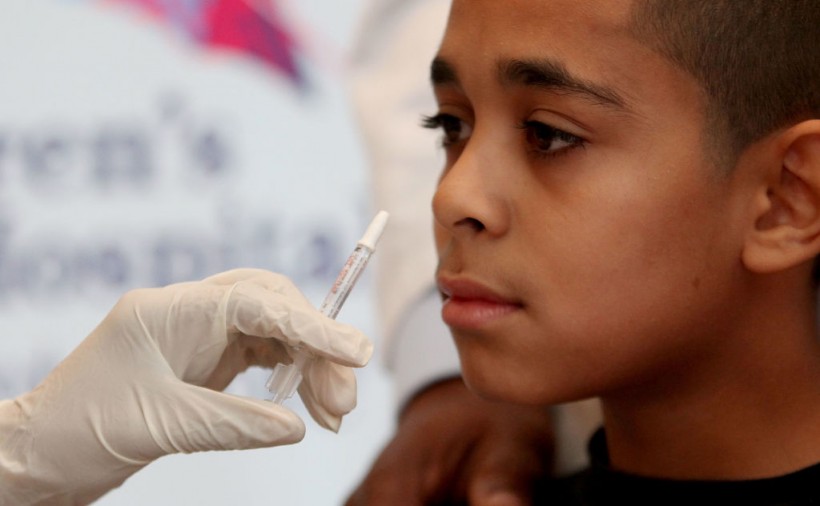A new study recently showed how intranasal vaccine contributed to complex immune responses, resulting in strong cross-protection in mice against influenza.
As specified in a EurekAlert! report, an influenza vaccine given through the nose and developed with nanoparticles that improve immune response provides strong protection from various influenza virus strains, researchers from the Institute for Biomedical Science at Georgia State University said.
Specifically, the intranasal vaccine has PEI-HA/CpG nanoparticles. PEI or polyethyleneimine, a vigorous and flexible delivery system. It can carry antigens, specifically hemagglutinin, HA, at the same time, that induce an immune reaction in the body and CpG or adjuvants, enhancing the immune response of the body to an antigen for optimal immunoenhancement.
Essentially, such comprehensive immune reactions and cross-protection were long-lasting, showing protection from the influenza virus over six months following immunization. Results of the study are published in the ACS Applied Materials & Interfaces journal.
ALSO READ: Body Clock Strongly Associated With High Risk of Alzheimer's Disease

A nasal spray dose of the H1N1/swine flu vaccine was administered to Brandon Marti, 13, at Montefiore Medical Center on October 6, 2009, in the Bronx borough of New York City.
Intranasal Vaccine
Intranasal vaccination is a perfect approach for infectious respiratory diseases like influenza. Seasonal influenza vaccines, in general, stimulate narrow immune responses that quickly decline, leaving populations susceptible to novel influenza variants.
Innovations in flu vaccine technology are needed to shield against a great range of influenza viruses. Intranasal vaccination can enhance the local mucosal immune response by stopping influenza infection at the portal of entry of the virus.
HA is a protein in the flu virus, playing a vital role in the virus infection's early stages. Influenza HA has a head region, not to mention the stalk region.
Existing vaccines against influenza stimulate immune responses against the HA head. However, this head region is highly changeable and accounts for reduced efficacy against different variants. Moreover, the HA stalk region is more conservative throughout various influenza virus strains.
Protein Antigens and PEI-HA/CpG Nanoparticles
Protein antigens that are "intranasally" administered are typically less able to incite an immune response, and thus, adjuvants are needed to have highly effective intranasal vaccines.
Adjuvants, like CpG, can improve and control immune responses, therefore improving the protection's potency and breadth.
According to the study's corresponding author and professor in the Institute for Biomedical Sciences at Georgia State, Dr. Baozhong Wang, the PEI-HA CpG nanoparticles exhibit favorable potential as a "cross-protective influenza vaccine candidate.
The combination of PEI and CpG in the PEI-HA/CpG nanoparticle group contributed to the complex immune responses, resulting in robust cross-protection.
Furthermore, combining CpG and antigens into the same nanoparticle enhanced cellar immune responses. The study findings that the nanoparticles substantially improved HA immunogenicity, or the ability to stimulate an immune response, providing cross-protection from various influenza various variants.
Essentially, the conserved HA stalk region prompted significant antibodies in the nanoparticle immunization groups.
Nanoparticle Vaccines
The study's first author, Dr. Chunhong Dong, a postdoctoral fellow in the Institute for Biomedical Sciences, explained that nanoparticle platforms had shown interesting characteristics and great potential in the next-generation cross-protective influenza vaccines' development.
Nonetheless, this is the first author's challenge to nanoparticle vaccines' successful research and development.
Even though no apparent negative impacts were observed in the research, a more comprehensive safety evaluation of the nanoparticle adjuvant system is required before clinical trials, as indicated by a similar Medical Xpress report.
Related information about the nanoparticles flu vaccine is shown on UW Medicine's YouTube video below:
RELATED ARTICLE: Study Shows Alzheimer's Could Be Predicted Through Writing Tests
Check out more news and information on Medicine & Health and Nanotechnology in Science Times.














